Throughout the recorded human history war has been a constant feature of our lives while there is also ample evidence to show that war existed even before humans could record and communicate their experience in language. As historian Michael Howard notes, the documented evidence indicates that war has been the universal norm in human history. For the inhabitants of the ancient world, war was experienced as a natural consequence of life. As societies evolved becoming democratised and military technology modernised, wars intensified and were transformed from the small wars of princes and kings to wars of people and entire nations in the twentieth century. Post the Cold War era did not lead to peace but was replete with multiple small wars in various parts of the world. The twenty-first century opened with the Non-State Actors’ misadventures and the subsequent wars against terror signified that war would remain an integral part of contemporary experience. In the current milieu, when the Russia-Ukraine conflict, Gaza crises and the US-China rivalry are being experienced, war seems to have become a permanent social relation and a kind of general behaviour to describe social organisations and relations of power in the contemporary world.
Communication plays a key role in our lives. It is believed that the natural aim of all communication is mutual understanding, so the war and all forms of conflict are assumed to be the result of breakdown of communication. It however seems contrary to the belief. War appears to be another form of communication and as a matter of fact communication continues throughout the war, both internally and externally. Let’s make use of Clausewitz’s most famous concept of “Trinity” as well as his words:
“War is merely the continuation of policy by other means,”
to substantiate this argument. War does not only forge a better communication between the government, people and military but also through every step one takes during the war or a conflict and intends to convey his intention to the adversary and suppress his will to fight, succumbing to one’s demands. For instance, even though you are not engaged with the enemy via other forms of communication, you are still communicating with him through destructive means and continuously conveying your might, intentions, resolve and desires. It is also the time when nations, governments and militaries come closer to each other.

Not only this, but there is constant communication with other audiences such as allies, partners and friends to convey to them their own will and agenda. It is thus an explicit way of communication internally, externally and laterally. In the contemporary world characterised by global spread of communication, awareness and experience of real or media mediated wars is increasingly acknowledged. We can safely assume that mass media reporting on war is the single most popular topic that attracts audiences to the extent that war is usually considered as the indicator of the health of the media.
This shows the essence of communication that lies within the war effort which is deliberate and to a great extent directed towards the target audience. It is but common that media is fed with the war effort and the corresponding narratives to shape a conducive environment for achieving political objectives driving the overall effort.
Given its nature as a means of communication unchanged, the character of war has certainly been changing with the evolution of technology. The wars which were fought hand to hand took a course of long-range vector attacks and have now rested on virtual means.
Today, the relationship between war and communication is stronger than ever before. We now live in a virtual world as we spend more time with our gadgets than with humans; just think that we are connected more often with our families, businesses, jobs and the world through internet.
With the advancement in technology, adversaries aim to disrupt this communication by attacking the vital communication nodes that link humans. Thus, the aim is to break communication between humans, systems and processes which causes paralysis. It is discreet and dangerous as mostly one doesn’t even come to know of an enemy’s attack which paralyses the virtual life when connectivity with each other and the world is impeded. We can safely say that today the concept of victory has changed.

Now, the focus is not on gaining something but denying your adversary of the use of vital communication link with the world because in that way the adversary is deprived of pivotal facilities and commodities during the war which causes paralysis in the whole society, thus affecting decision making process of its leadership.
Also, because war is an internal communication with the local audience, concerted and focussed effort is directed towards communicating own narrative to the targeted audience which is the hallmark of today’s war strategy. So doing less and projecting more has become a norm. Today, despite having a mega arsenal in its inventory, an adversary can actually do little on ground but can surely amplify the effort in the eyes of the international and local audience to convey its might, resolve and intentions. This is a growing trend and can be witnessed during India’s False Flag operations against Pakistan since year 2016. Also, the Russia-Ukraine war, the Gaza conflict and Iran-Israel spat have manifested this concept where the adversaries have been blocking communication of the opponent and projecting their own successes. India’s obsession with the Net Security Provider in the Indian Ocean is also rested on this premise.
One fillip side of this new character of war is the encroachment of authority of decision makers on either side. As communication is not the property of any one side, there is always an effort to counter adversary’s narrative by twisting it in own favour. In that case, the happenings during a war may not proceed as intended originally – this is an interesting and unique phenomenon since it encroaches upon the authority of decision makers who at times find themselves in a quandary on how to continue with their plans.
Therefore, it is not only important to build a narrative but also to protect it from an adversary’s counter narrative. Because of the availability of communication technology to the civilians, there is always a danger of third party’s intervention who can further complicate the situation for both adversaries. This is another threatening angle to this whole situation and the evolving phenomenon is worrisome which needs to be accorded due attention.
The upcoming trend is dangerous because it is fluid and invisible. For instance, in physical interaction during the war, there are tangible signs of aggression that an adversary creates against the other, providing rationale for response. But in virtuality, one may not even come to know about the attack while receiving serious damage till it is too late. The rationality to respond is established quite late giving leverage to the aggressor to capitalise on his success. It is also important to understand that time is critical in a conflict and with the passage of considerable time to respond, the rationality to react is sometimes lost.

Hence in today’s era, there is a need to take whole lot of actions and measures required before any conflict situation arises between the adversaries. And for that, a comprehensive communication strategy is to be charted to tackle a situation whether it can be visualised or an unexpected action by the adversary. The comprehensiveness of this strategy does not only mean covering expected and unexpected situations but also involving all tiers and stakeholders including the populace both horizontally and vertically. Here, conformance to the Clausewitz’s Trinity becomes paramount.
There has to be a paradigm shift in thinking about role of paradigms in war. The current scenario where the character of war has gone virtual more than physical may especially prove catastrophic, particularly between Pakistan and India since incapacitating the adversary in their case may cast serious negative imprints on the strategic decision making.
The nuclear neighbours are arch-rivals and have fought wars as well as skirmishes throughout their history post-independence. Serious issues are still pending between both which have the potential to instigate a conflict situation at any time. In order to save more than billion souls in South Asia, it is incumbent upon the leadership from both sides to seriously review this situation and take appropriate measures. Not only that, focus on changing character of war is to be accorded due diligence but there is a serious requirement of engagement from both sides in this domain to avoid any inadvertent miscalculation. Confidence Building Measures (CBMs) to address these issues therefore should be a serious consideration.
This necessity should not be overwhelmed by the differences and issues between the two, instead, they need to be forthcoming in agreeing upon factors to avoid such eventuality from either side. After all, there has to be a paradigm shift in thinking about the role of paradigms in war.





